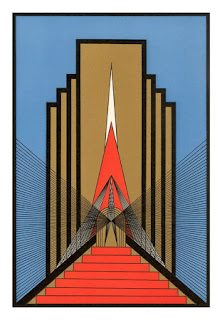My next few props that I'll be modelling are going to be:
A cigar; a cigarette; a cigarette lighter; and an ashtray.
Tuesday, 30 November 2010
We'll table this for now
Stool Sample
But what was his Motif?
I started making some decorations that could be used on furniture/architechture to give it a more art deco look.
supports
When discussing the final bar layout, I brought up the topic of structural support.
I felt that perhaps some kind of additional structural support would be needed to maintain the structural integrity of the ceiling.
I felt that perhaps some kind of additional structural support would be needed to maintain the structural integrity of the ceiling.
 |
| Here I suggested the use of structual support coloumns. |
 |
| In the end we decided that the room was originally two rooms, and that the wall had been knocked through. |
furniture
 |
| Add caption |
 |
| Add caption |
 |
| Add caption |
 |
| Add caption |
 |
| Add caption |
 |
| Add caption |
 |
| Add caption |
 |
| Add caption |
 |
| Add caption |
 |
| Add caption |
 |
| Add caption |
 |
| Add caption |
 |
| Add caption |
 |
| Add caption |
 |
| Add caption |
 |
| Add caption |
 |
| Add caption |
 |
| Add caption |
 |
| Add caption |
 |
| Add caption |
 |
| Add caption |
 |
| Add caption |
 |
| Add caption |
 |
| Add caption |
 |
| Add caption |
 |
| Add caption |
 |
| Add caption |
 |
| Add caption |
posters
As a group we decided we might use posters in our environment, so I looked at examples of 1920's - 1930's posters.
 |
| Here's a poster advertising the World's Fair in Chicago in 1933. |
 |
| The train depicted in this poster is very art deco. |
 |
| An underwear advert. This poster shows the fasion of hair styles of women in the 30's. |
 |
| A poster of the Empire State building. |
 |
| This poster advertises a transatlantic passenger ship. |
 |
| Add caption |
 |
| Add caption |
 |
| This painting from the 30's shows the angular, bold lines that are characteristic of art deco. |
 |
| An advert for a cognac (this advert is from france, as in the US prohibition was still in effect). |
 |
| Add caption |
buildings
As a starting point for my visual research into Art Deco, I looked into Art Deco architechture.
Art Deco has it's roots in the visual styles that were discovered inside ancient temples and tombs such as the pyramids in Egypt and Mayan/Incan temples in South America. Tutankhamun's tomb, for example, was discovered in 1922 by Howard Carter.
Art Deco has it's roots in the visual styles that were discovered inside ancient temples and tombs such as the pyramids in Egypt and Mayan/Incan temples in South America. Tutankhamun's tomb, for example, was discovered in 1922 by Howard Carter.
 | ||
| The visual stylings of this entranceway wall have pyramid. |
 |
| This door arch was clearly influenced by Mayan architechture and patterns. The angular, stepped style is reminiscent of Mayan ziggurat temples. |
 |
| Sharp, angular, stepped features are the hallmarks of Art Deco architecture. |
 |
| Extravagant use of strong, hard, building materials (in this case marble) are a frequent element of interior Art Deco arcitechture. |
 |
| The integration of smooth, regular curves (especially circular ones) into the harsh angles is another common feature of art deco architecture. |
 |
| The Empire State Building and the Chrystler Building are two of the most iconic art deco styled buildings in the world. Both of them were built in the beginning of the 1930's. |
 |
| The City Hall in Buffalo has one of the best examples of the use of ziggurat-like stepped structure. |
 |
| The overly elaborate carved motif that make up the decoration on the back wall in this photo are reminiscent of the wall paintings and hyrogliphics from ancient egypt. |
 |
| Dark woods, marble, and polished metal. Three common art deco materials. |
 |
| Excessive use of circular curves and sharp angles. This bar is aclassic example of art deco. |
 |
| An old bar, mostly still as it was when it was build in the 1930's. |
Subscribe to:
Posts (Atom)





